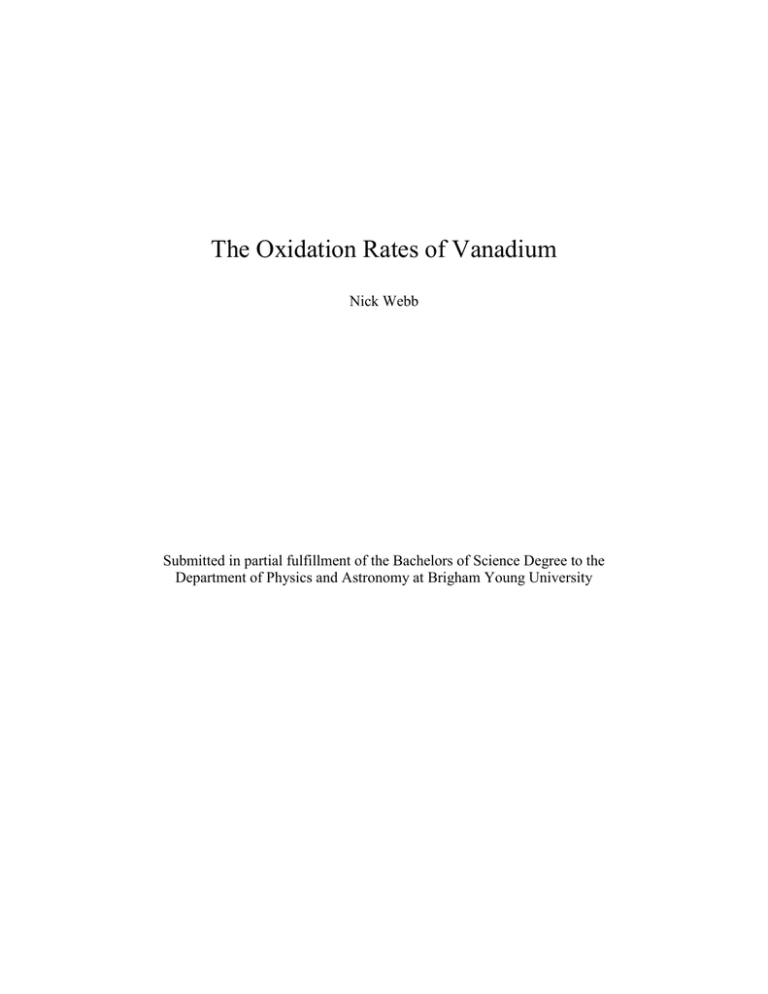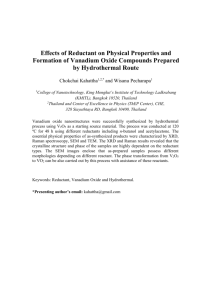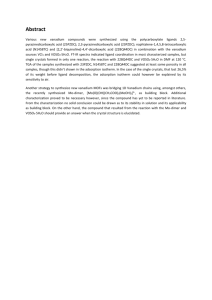Vanadium
advertisement

The Oxidation Rates of Vanadium Nick Webb Submitted in partial fulfillment of the Bachelors of Science Degree to the Department of Physics and Astronomy at Brigham Young University 1 Background and Motivation 1.1 Intense research is currently being conducted in the area of thin films. As the drive for smaller and faster transistors continues, photolithography machines will be using increasingly shorter wavelengths of light, extending deep into the ultraviolet. In order for these machines to work, they must have the optical components necessary to reflect and focus the light. 1.2 There has been recent efforts to place ultraviolet telescopes and other UV detectors in orbit around the Earth. These will scan the universe for sources of UV light that are otherwise undetectable under Earth’s atmosphere. 1.3 New UV lasers will need to have high reflecting mirrors in order to sustain lasing. 1.4 Thin film mirrors will be applicable in all these fields. A large amount of research on how materials and different combinations of them will perform in the UV. Many things must also be considered such as: -Do the layers interact with each other? -Are the compounds involved stable? -Does the top layer oxidize? How much? How fast? -What are the optical properties of this top oxide layer? -Do intermediate layers oxidize during deposition? -Does oxygen transport down through grain boundaries to oxidize deeper layers? -Do extremely thin films of these materials behave differently than the bulk films? 1.5 Various Russian theoreticians have theorized a theoretical reflectance of over 70% (in theory) from vanadium/silicon multilayers at a photon energy of around 13 eV. This paper will primarily examine a few of these issues as they pertain to vanadium and its oxide, and provide background on the research methods involved, as well as the remaining questions that need addressing. 2. Multilayer Fabrication 2.1 Thin films can be deposited in a surprisingly large variety of ways. A popular method was inspired by rareified gas lamps. As the plasma is excited in the bulb, it begins to eat away at the electrodes, causing them to degrade over time. Ever see a flickering fluorescent tube? That’s right, the electrodes have been partially sputtered away. Yes, sputtering is what happens when ionized (insert favorite gas here) bombards a solid surface, and blows away the atoms. 2.2 I used a DC magnetron to make layers of vanadium that were to be oxidized, and an rf magnetron sputtergun to deposit vanadium and measure it in-situ. 2.3 Magnetrons operate by having a magnet underneath the target material direct where the energetic gas ions will blow away atoms on the target. As you might have guessed, DC means direct current, ie a direct current is what excites the gas, and rf sputtering uses a radio frequency current to ionize the gas atoms. Rf is primarily used for insulating material, while DC is used to sputter metals. 2.4 Sputter rates will vary depending on power, target temperature, substrate temperature, target purity, geometry of the target, phase of the moon, disposition of wife, along with a slew of apparently related parameters. My substrates were always at room temperature, with a moderate power applied (about 500 watts), with a decently pure and clean target of vanadium. Though not perfectly clean, the target and substrates were sufficiently clean for my purposes. 2.5 All told, my films for oxidizing in the oven turned out to be anywhere from 4 to 14 nm, and the one I did in-situ was around 100 nm. 3 Ellipsometric Analysis 3.1 Ellipsometry simply put, measures the polarization of light after it has been reflected from a sample. Light at a certain wavelength will be generated, go through a polarizer, hit the surface at some angle, interact with the surface, reflect off at some new polarization, and go through a rotating analyzer which will read what the new polarization and intensity is. The ellipsometer will then run a few calculations and tell you what Psi and Delta are for that wavelength and angle. See any optics book for more details. 3.2 Armed with information about Psi and Delta at a variety of wavelengths and angles, the savy ellipsometer user can then input a mathematical model that the program will then use to fit for the thickness, or the index of refraction if you tell it a thickness, or the absorption coefficient, or two of those three if you really know what you’re doing and you have a really good, clean, smooth sample. 3.3 Speaking of smooth samples, surface roughness can have an effect on the ellipsometric measurements. Fortunately, previous generations of physicists have already figured an approximate way around that by enabling the user to input an approximate roughness value into the fit program, and your roughness problem is approximately solved. The method involves approximating the roughness as its own layer, with about 50% air and 50% of the layer beneath it. The effect of this layer is then taken into account in the whole mathematical model. 4 In-situ Deposition and Ellipsometric Measurements 4.1 We have a device that permits us do rf sputtering, and ellipsometry inside the deposition chamber. This means that there is no oxygen to oxidize the layer so the ellipsometer is reading only virgin metal and not any of its oxide. 4.2 D-Day. Deposition day. The chamber was pumped down to a base pressure of 106 torr. Argon gas was introduced to the chamber on the order of 10 mtorr. The rf plasma was started, and a nice layer (about 1000 nm) of vanadium was put down on a silicon wafer. Real time ellipsometry measurements were taken to tell us when the ellipsometer could no longer see through the metal layer to the substrate beneath. When the data stopped changing, we knew it was ready. This meant the layer had become “optically thick”, meaning that in any future ellipsometric analyis, the substrate would not interfere in any measurements. 4.3 One final measurement was taken a few seconds after the plasma was shut off. Using this data, I then coaxed the ellipsometer program to calculate some optical constants using a lorentz oscillator model for the layer. The constants I calculated closely matched the ones found in the literature, except for my absorption coefficient values. Those are a little lower, which might just be because my vanadium target was not as pure as it could have been. This does not matter because the films I will be making will be made with this target, so I have the constants that I need. Oxidation Study 5.1 A sample of pure vanadium oxide was made, and an ellipsometric scan yielded data on the optical constants: Optical Constants of VOx 3 2.5 2 n, k 5 n 1.5 k 1 0.5 0 2 3 4 Photon Energy (eV) Figure 1 This data along with the vanadium optical constants then allowed me to characterize the thickness of any vanadium/vanadium oxide layers that I subsequently made. 5.2 I then made several vanadium samples in the DC magnetron chamber, and rushed them over to the ellipsometer to get an initial measurement. The samples were then annealed at different temperatures, first for only a few minutes at a time, then for several hours at a time: V and VOx at 140C y = 8.3509x + 7.8872 R2 = 0.9713 140 Thickness (A) 120 100 VOx V 80 Linear (VOx) Linear (V) 60 40 y = -2.6752x + 78.226 R2 = 0.9724 20 6 8 10 12 14 16 ln(t) (sec) Figure 2 The data appears to be linear when the natural log of time is plotted against the thickness. This would suggest a thickness-time relationship of the form d = aln(t) + b where d is the thickness, b is the initial thickness, and a is a constant which takes into account pressure, initial thickness, as well as the temperature dependent term exp(-E/KT). Taking the derivative of both sides, we obtain r(t) = a/t, or more descriptively: Rate(t , T ) R0 e t E KT where Ro is now the original constant “a” with all information about temperature removed. From the data it appears that the oxidation rates look like this: Temperature (C) 25 60 90 140 Rate 2.8/t 2.3/t 10.3/t 8.4/t As a sidenote, it appears that the oxide appears three times as fast as the metal disappears. From this we can make a good guess that the oxide is VO2, though that is not relevant to the discussion. We can now say a = Ro * exp(-E/KT). Taking the natural log of both sides, we obtain ln(a) = -E/KT + ln(Ro). So by graphing all the natural logs of the original constants “a” versus the inverse of temperature, we can calculate the activation energy of the oxidation reaction. Rate vs 1/T 2.5 2 ln(rate constant) y = -2167.2x + 8.2984 thickness 1 1.5 thickness 2 n Linear (thickness 1) 1 Linear (thickness 2) y = -2201.7x + 7.4532 0.5 0 0.002 0.0022 0.0024 0.0026 0.0028 0.003 0.0032 0.0034 0.0036 1/T figure 3 5.3 From the data, the activation energy of the oxidation reaction is .128 eV. Because of the decaying exponential nature of the oxidation rate, we can expect to see no appreciable oxidation after several weeks at ambient or several days at temperatures approaching 140 C. 5.4 My data suggests that there is a dependence of the oxidation rate on the metal thickness, or possibly the metal/oxide layer thickness ratio. The two different lines on the graph are for the two different thicknesses I studied, and the similar slopes only offset by a constant seem to suggest the dependence on thickness. More studies with many different thicknesses and temperatures would be needed to really nail down this dependence on the metal/oxide thickness of the rate. Conclusion It has been shown that vanadium readily oxidizes at ambient temperatures and much more quickly at elevated temperatures, with rates ranging from 2.3/t to 10.3/t (both in Angstroms/second). The swell factor of the oxide is about 3. The activation energy of the oxidation reaction is .128 eV. The optical constants of vanadium were also obtained and shown to be consistent with already published values, as well as optical constants for vanadium oxide which as of now I don’t believe have been published. More work needs to be done to determine the effect of metal/oxide thickness on the oxidation rate. Some work was also done with vanadium oxide in the extreme ultraviolet region, though that data has yet to be analyzed.


